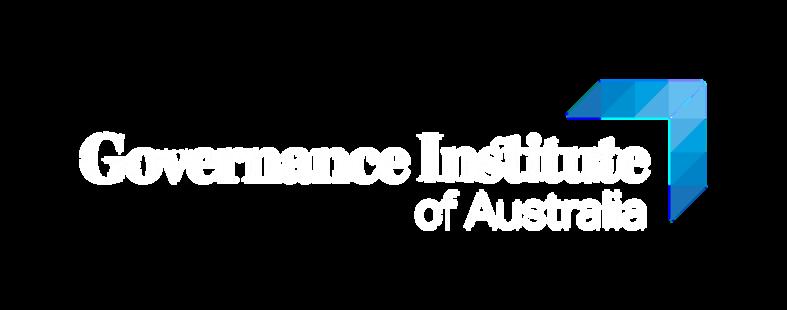Governance Directions

Climate disclosures are here. Is your board ready? More money flowing through local charities is good news, but why does it bring sharper scrutiny?



Climate disclosures are here. Is your board ready? More money flowing through local charities is good news, but why does it bring sharper scrutiny?


Climate disclosures are here. Is your board ready?
Strengthening protections for those who speak up
Governing innovation responsibly: What the ACCC’s renewable gas case reveals Acting For You
More money flowing through local charities is good news, but it also brings sharper scrutiny.
A national membership association, Governance Institute of Australia advocates for a community of governance and risk management professionals, equipping members with the tools to drive better governance within their organisation.
Our contact details
National office 1800 251 849 (02) 9223 5744
Level 11/10 Carrington Street, Sydney NSW 2000
sales@governanceinstitute.com.au
Call us on: 1800 251 849
Submissions:
Members of Governance Institute and others are welcome to submit articles for consideration. Please contact the editorial office for details and guidelines at media@governanceinstitute.com.au
Disclaimer:
All expressions of opinion in this journal are published on the basis that they are not to be regarded as expressing the official opinion of Governance Institute of Australia, unless expressly so stated. Governance Institute of Australia, authors and all persons involved in the preparation and distribution of this journal, are not thereby giving legal, accounting or other professional advice and hence do not accept any responsibility for the accuracy of any of the opinions or information contained in the journal. Readers should not act or refrain from acting on the basis of opinions or information without first taking appropriate professional advice in respect of their own particular circumstances. Governance Institute of Australia does not accept any liability to advertisers for the publication of advertisements which may be held to be contrary to law. Material published in is copyright and may not be reproduced without permission. Governance Directions
Dear members:
Resilience isn’t just a buzzword, it’s become a daily reality for many organisations Across the not-for-profit and charitable sector in particular, leaders are grappling with rising operational costs, shrinking income streams, and a surge in service demand, all against the backdrop of sustained economic pressure from a cost-of-living crisis
But even under these conditions, we continue to see remarkable leadership and clarity of purpose What sets the most resilient organisations apart isn’t luck, it’s good governance Strong governance provides the structure, foresight and accountability that helps organisations stay mission-focused, adaptable and effective, even in the toughest conditions.
This is the spirit behind our Not-for-Profit Governance Forum, happening this month.
We’ll bring together leading voices from across the sector to talk about how organisations are navigating these challenges, aligning service delivery with sustainability, strengthening board direction, using technology to boost access and efficiency, and embedding governance practices that drive impact
We’ll also be hosting our Indigenous Governance Forum, where we’ll explore what strong, self-determined governance looks like in First Nations communities. Indigenous governance models are grounded in culture, identity and connection to Country, and they’re often leading the way in community-led service delivery, policy influence, digital access, and climate action We’ll hear from leaders at ORIC, ASIC, ACNC and Indigenous organisations about what’s working, and how mainstream governance can learn from these models
Across both forums, the common thread is clear: resilient governance is proactive, people-focused, and adaptable That’s the kind of governance we aim to champion, and the kind we want to help our members continue to build.
We’re also finding new ways to bring you the conversations that matter most. We recently launched our new vodcast series, Another Good Decision, available on YouTube and Spotify Each episode dives into the big issues shaping the future of governance, from cyber resilience and ethical leadership to innovation, regulation and more It’s designed to keep you informed, inspired, and connected
Thank you, as always, for being part of this community I hope to see you at one of our upcoming forums, or to have you tune in to Another Good Decision.
Best regards,
Katrina Horrobin


Insights from sustainability specialist SiobhanToohill, plus the policy moves boards need to watch.
Australia’s climate related financial reporting rules apply to the country’s largest companies, with thousands more organisations coming into scope over the next two years. The disclosures that began in January sit alongside wider environmental, social and governance reforms, from modern slavery updates to gender equality targets that will publicly name employers who fall short
For SiobhanToohill, a veteran sustainability executive and one of Australia’s first listed company chief sustainability officers, the shift was inevitable

“We’re now shifting to a moment where sustainability is becoming much more embedded, integrated into how we do business.”
Canberra’s climate push is only one part of a policy suite that is reshaping board agendas The federal target of 82percent renewable electricity by 2030 is locked in, adding pressure to high emitting assets and supply chains
From 1July2025 a national battery subsidy will cover about 30percent of household installation costs, aiming to put more than one million systems in homes by decade’s end.
Heavy industry can also tap new incentives: a twodollar a kilogram credit for hydrogen production and a 10percent tax break for processing critical minerals, both funded through the Future Made in Australia package
On the social front, employers with at least five hundred staff will need to set and report on gender equality targets from April2026 Plans to tighten modern slavery rules are also on the horizon
Toohill has spent more than twenty years guiding companies through environmental risk She says the governance conversation has changed
“Boards need to make sure that they’ve got the knowledge that they are well educated. Now, they don’t need to have deep expertise, but they’ve got to understand what their role is around broadly sustainability.”
Directors must now grasp climate science, regulatory timetables and scenario analysis. Many organisations will rely first on existing finance and procurement systems to capture data for their inaugural climate reports, and Toohill urges them to make the most of those tools before buying new technology
Regulators, including ASIC and the ACCC, are testing sustainability statements more closely. Toohill says every claim must rest on solid ground.
‘The sooner boards embed sustainability into mainstream governance, the better placed their organisations will be in Australia’s fast evolving low carbon economy.’
“Have I got evidence? Have I got information, data logs, board minutes that substantiate why we think this is a reasonable claim?”
Some companies, fearful of missteps, are staying silent about genuine progress.
“That’s a shame if we miss out on those stories. We don’t want to see organisations limiting their ambition or innovation.”
Net zero pathways begin in the boardroom
Investors are treating emissions exposure as a financial risk, and Toohill warns that directors need a clear route forward
“You don’t need to have the complete answer, but you need to understand what the different pathways are.”
Mapping those pathways means tracking emissions across operations, supply chains and product use, then setting interim milestones and putting oversight with the board.
Unmanaged climate risk, she notes, could be viewed as a breach of directors’ duties under the Corporations Act.
The environmental agenda is widening. The Australian Sustainable Built Environment Council wants a 60percent cut in embodied carbon by 2035 and a “reuse first” mindset for buildings.
Modern slavery reforms promise tougher due diligence Workplace gender targets, backed by public reporting, will lift scrutiny of corporate culture
The ACCC also plans to let banks and investors share natural capital data, a sign that collaborative, sector wide approaches to sustainability are on the rise.
For directors facing their first climate report, hesitation is the bigger risk
“Just get started, and dive in and start to grapple with what you need to do”
The sooner boards embed sustainability into mainstream governance, the better placed their organisations will be in Australia’s fast evolving low carbon economy.
Upskill now to navigate regulatory change, avoid greenwashing risks, and build strategy in a lowcarbon economy. Don’t wait for disruption. Lead it.
Sign up for our Sustainability Reporting or our Environmental, social & governance (ESG) today.




An independent Whistleblower Protection Authority is on the cards, as an active inquiry and report being undertaken by the Legal and Constitutional Affairs Legislation Committee on the Whistleblower Protection Authority Bill 2025 (No 2) gets underway
The Bill would establish a new, independent statutory authority (Whistleblower Protection Authority) responsible for providing information, advice, assistance, guidance and support to whistleblowers and potential whistleblowers.
The Authority would have jurisdiction over all federal whistleblower protection laws
Currently whistleblower protection laws are a complex patchwork of federal and state legislation, including the Commonwealth Public Interest Disclosures Act, Fair Work (Registered Organisations) Act, the Corporations Act, the Aged Care Act, Taxation Administration legislation as well as various State-level legislation.
The area is complex to understand, complex to administer and confusing for anyone contemplating speaking up about unlawful, unethical or irresponsible behaviours

Governance Institute has been a long-term advocate for improved whistleblower protections and a sector agnostic whistleblower protection authority We have endorsed the Transparency International, Griffith University and Human Rights Law Centre Draft Design Principles for a Whistleblower Protection Authority as well as the Federal Roadmap report.
The design principles emphasise the need for independence, comprehensive and seamless jurisdiction as well as adequate powers and resources to deal with legal actions, mediation and administrative redress
The design principles also highlight the need for improved access to remedies, prevention of whistleblower mistreatment and enhanced support for whistleblowers through timely enforcement activities and education.
The Bill proposes a set of functions, powers, rights and obligations that a Commissioner would assume as the to the Authority.
In our submission to the inquiry, we emphasised the critical role that the Commissioner to the Authority would play in investigating whistleblower protection issues, including powers to refer, coordinate and triage whistleblower disclosures.
Critically, the Commissioner should have authority to oversee and manage the investigation in a timely manner and lay recommendations about any allegation, or matter that triggers a whistleblower investigation issue
The WPA is an important step in protecting the legal, financial and human rights interests of whistleblowers and will go a long way in correcting the disincentives for disclosure of unethical behaviour and misconduct.
There are other inquiries at play, including a substantive phase of amendments to the Public Interest Disclosure Act currently under review with the Attorney-General’s Department There is also a five-year statutory review into whistleblower protection amendments covering private sector whistleblowers in the Corporations Act due to be released by Treasury later this year.
The Legal and Constitutional Affairs Legislation Committee is due to issue its report to the Senate on Monday, 29 August. th



By Dr Turlough Guerin FGIA

Regulators are tightening expectations on environmental claims, as seen in the ACCC’s action against AGN Boards must ensure that forward-looking sustainability messaging is credible, defensible, and aligned with technical and financial realities Boards should apply structured oversight to innovation pathways, recognising that emerging technologies require clear evidence, staged development, and governance discipline before being positioned as market-ready. Understanding the link between investment conditions and innovation maturity is essential, as current gas prices remain below viability thresholds for renewable gas. Directors must factor market signals into decisions about when and how to support and communicate emerging solutions
The ACCC case: A line in the sand?
The ACCC’s legal action against Australian Gas Networks (AGN) over its “Love Gas” campaign marks a turning point in how Australia regulates forward-looking environmental claims.
At issue are public statements suggesting that household gas is “becoming renewable” and promoting a “renewable gas future” The ACCC alleges that these statements lacked reasonable grounds and could mislead consumers, triggering proceedings under Australian Consumer Law
This enforcement action has drawn strong views. Some regard it as regulatory overreach that risks stifling innovation. Others see it as a necessary step in holding companies to account as they navigate the clean energy transition.


Industry professionals point to global momentum: countries such as Denmark and Germany have already scaled biomethane injection into national gas grids. In Australia, both hydrogen and biomethane are acknowledged within national and state decarbonisation plans.
I should note that I am personally a strong supporter of greater ambition in this sector. Renewable gas, including biomethane-to-grid, is a critical part of the transition to net zero. These innovations are not speculative; they are already being scaled internationally and are expected to become a reality in our domestic energy mix when the technical and financial requirements are fully aligned.
As I argued previously in Governance Directions, directors must take care not to overstate environmental benefits. Greenwashing is not always about false intent, it can arise from well-meaning but unverified claims. In the AGN case, public messaging appeared to present an imminent transition to renewable gas when in reality, the technologies remain at the pilot and early deployment stage.
The underlying issue here is also one of technical complexity Renewable gas pathways, whether through hydrogen blending or biomethane injection, are highly specialised areas involving engineering constraints, regulatory boundaries, evolving market dynamics, and of course, financial viability It is unrealistic to expect that non-technical communicators or generalist executives will grasp all the nuances of these systems
That is why I have consistently advised that marketers and sustainability communicators work closely with technical teams to ensure that claims are not only ambitious but also accurate, defensible, and properly framed.
This misalignment reflects a classic strategy–execution gap: bold sustainability ambitions that have yet to be grounded in technical or commercial readiness From a governance perspective, forwardlooking environmental narratives must now meet the same threshold of oversight and substantiation as financial statements
The AGN case offers important lessons for directors and senior leaders. Here are some that I can see:
Forward-looking claims must be evidencebased, with a clear and defensible delivery pathway
Marketing and investor communications functions should be subject to board-level oversight, especially when tied to ESG objectives
Apply formal instruments such as Technology Readiness Levels (TRLs) and Life Cycle Assessment (LCA) when developing sustainability messaging. Recognise that greenwashing now carries legal and governance implications, not just reputational ones.
Climate risk oversight is no longer optional. Today, the same principle applies to how organisations communicate their sustainability intentions If those messages shape public or consumer trust, they are within the remit of the board
The AGN case illustrates a common challenge when emerging technologies are communicated to mass
markets before the enabling systems, technical, regulatory, and financial, are ready.
This is where Strategic Niche Management (SNM) offers practical guidance. Developed within sustainability transitions theory, SNM provides a structured model to help policymakers, innovators, and corporate leaders support early-stage technologies as they move from concept to market SNM describes three essential phases in the responsible scaling of innovation:
Shielding – Innovations are protected from market forces during R&D and demonstration stages
Nurturing – Stakeholders collaborate to learn, refine, and adjust based on real-world feedback. Empowering – Technologies are scaled once institutional, regulatory, and technical systems are ready.
One strong example of SNM in practice is the Australian Renewable Energy Agency’s (ARENA) investment strategy, which supports innovation across hydrogen, biomethane, and electrification technologies ARENA shields early-stage projects through co-investment, nurtures knowledge-sharing and iterative learning through technical trials, and empowers scaling through market integration and regulatory interface design
Another clear example is the Materials and Embodied Carbon Leaders’ Alliance (MECLA), which was initiated through the NSW Government’s Sustainability Advantage program. MECLA has grown into a national collaboration between government, industry, and research organisations, creating a structured and protected space to develop and test low-carbon construction materials and procurement models.
Through working groups, pilot demonstrations, and policy engagement, MECLA has nurtured early adopters while helping lay the foundation for system-wide decarbonisation of the built environment
From 2019 to 2020, prices remained relatively low at $6–$9/GJ due to stable supply and subdued demand In 2021, prices began to climb, reaching $10–$12/GJ A sharp spike followed in 2022, with prices soaring above $30/GJ in some markets, driven by global energy disruptions and increased LNG demand Government interventions and improved supply helped moderate prices in 2023–2024, bringing them down to $10–$14/GJ. As of 2025, prices have continued to stabilise at around $9–$12/GJ, reflecting a more balanced short-term outlook.
My own research indicates that for alternative gas investments, such as biomethane-to-grid infrastructure (or renewable gas for consumer) as referenced in the ACCC case, to become financially viable at scale, conventional pipeline gas would typically need to be priced at around $14–15/GJ or higher (depending on scale and of course cost base for the various components)
In that context, unfortunately, the current market signals are not pointing in the right direction While technical readiness and policy frameworks are evolving, the financial conditions to trigger widespread commercial deployment of renewable gas remain constrained, unless the cost of renewable gas comes down, which is expected to occur at some stage in the future. Exactly when that inflection point arrives, however, remains the multimillion-dollar question. In contrast, the AGN campaign appears to have bypassed these preparatory phases, presenting
renewable gas as commercially ready when many supporting systems are still evolving The result is not only reputational risk, but a potential chilling effect on public support for legitimate clean energy transitions
From a governance standpoint, SNM reminds us that innovation should be paced and guided, not just accelerated. Boards and executives must understand where technology truly sits in its development curve before translating it into customer-facing claims or strategic commitments.
Australia’s clean energy future depends on innovation, hydrogen, biomethane, electrification, and more. But these innovations must be communicated transparently and governed responsibly. The AGN case is not a condemnation of renewable gas. Rather, it’s a timely reminder that good governance is essential to building public confidence in clean energy pathways
For directors, the message is clear: embed ESG assurance, align public messaging with technical readiness, and ensure that sustainability claims are accurate, auditable, and accountable
Dr Turlough Guerin FGIA is a non-executive director, board advisor and an Honorary Fellow at the University of Melbourne.
ACCC (2024, June 24) Australian Gas Networks in court over alleged greenwashing in renewable gas campaign Retrieved from https://wwwacccgovau/media-release/australian-gas-networks-in-court-over-allegedgreenwashing-in-renewable-gas-campaign
ACCC (2023) Making environmental claims: A guide for business Retrieved from https://wwwacccgovau/aboutus/publications/a-guide-to-making-environmental-claims-for-business
Guerin, T F (2021) How climate risks are impacting directors in their various board roles: A view from Australia Directors Today, 2021(4), 36–39 https://wwwiodglobalcom/uploads/newarticle pdf/1636527263how-climate-risksare-impacting-directors-in-their-various-board-roles-a-view-from-australia-dr-turlough-f-guerin-novemberdt2021pdf
Guerin, T F (2022) Business model scaling can be used to activate and grow the biogas-to-grid market in Australia to decarbonise hard-to-abate industries: An application of entrepreneurial management. Renewable and Sustainable Energy Reviews, 158, 112090. https://doi.org/10.1016/j.rser.2022.112090
Guerin, T. F. (2023, February). Directors must take care not to overstate environmental benefits of products and services. Governance Directions, 75(1), 17–19.
MORE MONEY FLOWING THROUGH LOCAL CHARITIES IS GOOD NEWS, BUT IT ALSO BRINGS SHARPER SCRUTINY


In March this year the federal government opened a new tax deductible pathway for community foundations. Assistant Minister for Charities AndrewLeigh said the reform “will make it easier for people to support charitable foundations in their local area,” helping the nation move toward its goal of doubling giving by 2030
Before March, most community foundations could not issue tax-deductible receipts without partnering with another Deductible Gift Recipient (DGR) charity. The new guidelines remove that hurdle, taking effect immediately. From 1July boards enter their first full year operating under these simpler tax rules, opening the door to larger gifts, provided they are registered as a charity with the Australian Charities and Not for profits Commission.
More deductible dollars bring higher expectations.
The Australian Taxation Office has fresh funding to step up compliance work and will be asking whether charities are truly “operating for purpose and applying income and assets solely for that purpose,” or whether “purpose creep” and oversized reserves have begun to slip in
CatherineMaxwell, General Manager of Policy & Advocacy at Governance Institute of Australia, explains what that means in practice.
“The new rules are a game changer for community foundations. But with greater opportunity comes greater responsibility.
“Ethic outco “Boar their m and w regula Turn Gover quick
1 Pu pa m aw
2.Ra de la ne gu pr 3.Co et Ex an ov Rais Clear, mone confid As thi an ob comm
Download Governance Institute of Australia’s Not-for-profit Good Governance Guides, resources purpose into action.

Expand your knowledge and expertise in governance and risk.

See Micro-credentials


FGIA FCG
by CATHERINE MAXWELL General Manager, Policy & Advocacy, Governance Institute of Australia
GIA Submission – APRA Governance Review: Discussion Paper
GIA made a submission to APRA on its governance proposals intended to uplift the governance standards for APRA-regulated entities The extensive proposals have attracted significant public comment
Our Submission:
Encouraged APRA to: consider the broader context for its proposals consider the broader context for its proposals and whether it is appropriate to be consistent with the ASX Principles and Recommendations and where possible not increase the regulatory burden on APRA-regulated listed entities have distinct aims or problems it is addressing in each proposal that is not currently addressed by other regulation or legislation, and use its existing powers to achieve its objectives and where it considers its powers are inadequate seek legislative reform rather than imposing requirements through prudential standards and guidance
Expressed the view that APRA’s should avoid the use of the term ‘capabilities’ in addition to ‘skills’ and ‘behavioural attributes’ in relation to directors, or clarify the term, including how ’capabilities’ differ from ‘skills’ and ‘attributes’, noting that the most appropriate way to confirm attributes is as part of the appointment process and the initial and ongoing fit and proper assessment
Recommended that a board skills matrix should only be used for skills and experience, not behavioural criteria

Expressed concern about the identification of individual directors’ skills and recommended flexibility about how entities implement verification of directors’ skills We also expressed concern about APRA’s proposal to be more involved in directors’ appointments
Sought clarification from APRA about what additional information it requires in relation to conflicts management, particularly from listed APRA-regulated entities which are already subject to a range of comprehensive disclosures
Recommended APRA reconsider its proposal to require at least two independent directors (including the chair) of a regulated entity are not members of any board within the entity’s group on the basis that it is likely to increase costs, reduce efficiency and create duplicative requirements without necessarily delivering a clear improvement in governance standards
Advocated that APRA retain its existing definition of ‘independence’ and aim for consistency with the ASX Principles and Recommendations
Requested public clarification from APRA that its proposal to extend ‘the current requirement for bank and insurer boards to have a majority of independent directors to include boards of entities with a parent that is regulated by APRA or an overseas equivalent’ is only intended to apply to APRA regulated ‘boards of entities with a parent that is regulated by APRA or an overseas equivalent
Recommended against a ten year lifetime tenure limit and that the expectation of a three-year external review be included in guidance, rather than in a Standard and that it be accompanied by text noting that there will be circumstances that warrant delay of an external review
Recommended against APRA providing any guidance on the role of the chair given there is case law and comprehensive guidance in existence, and
Supported APRA’s proposal to provide additional guidance on which APRA requirements may be delegated to board committees and senior management but noted there are practical difficulties because many APRA Standards will continue to specifically refer to matters as being matters for the board We sought clarification from APRA about how it intends to address this issue
APRA has indicated it will consider feedback from the three month consultation and intends to release updated prudential standards and guidance for formal consultation in the first half of 2026. It currently aims to publish the updated framework by the beginning of 2027 ahead of it commencing by 2028.
The Productivity Commission recently requested input on ideas it collected from responses to ‘Australia’s Productivity Pitch’. The Pitch involved the collection of over 500 ideas from across Australia on barriers and opportunities to improve productivity across the economy. The Commission combined this input with consultation with experts and stakeholders and its own research and expertise.
The ideas were grouped under fives themes: each involving a separate inquiry: creating a dynamic and resilient economy, building a skilled and adaptable workforce, harnessing data and digital technology, delivering quality care more efficiently and investing in cheaper, cleaner energy and the net zero transition
GIA made a submission which focused on two areas; creating a dynamic and resilient economy and harnessing data and digital technology.
We recommended:
That the Office of Impact Analysis, Treasury and Department of the Prime Minister and Cabinet undertake sector deep dives into the stock of regulation currently placed on Australian businesses, identifying where regulations may be duplicative, out-dated or ill-suited to regulatory objectives and statements of intent
That Government work with strategic partners to codesign an AI stewardship program for AI nascent entities to drive confidence and trust in AI across the business community
A safe harbour defence or enhanced regulatory sandbox for Australian AI developers and deployers to promote the safe and ethical use of AI in controlled environments.
The establishment of an independent, expert Corporate Law Reform Body to drive corporate, financial and securities law reform.
Government encourage agencies to adopt Simplification Consultative Group models and regulatory initiatives grids by coordinating across regulatory agencies and operating closely with industry bodies through consultative and integrated committees.
Government work with international jurisdictions to learn from recent privacy reform initiatives, understanding where objectives have worked well and where objectives may have failed to meet desired outcomes.
An outcomes-based approach to privacy reforms which should aim to carve out responsibilities for small business and not-for-profit operators from the Privacy Act, limiting the impact of the size, scope and penalties on small-sized operators
Further investigation of the merits of Digital Financial Reporting to ascertain the cost and benefits of mandating a paperless regime
Support for a significant uplift in capabilities at the individual and organisational level through business and education incentive programs that focus on AI literacy.
The mandating of ethical guardrails, particularly for high-risk user cases of AI, to limit potential harms to individuals.
The development of an AI compliance roadmap for business users of AI to make it easier for business owners to understand some of their compliance concerns and existing regulatory requirements when using and adopting AI in the workplace Government consider benchmarking or approving AI products and services, through compliant-bydesign AI approval checklists or through a government backed assessment of AI systems against meritorious criteria assessing the safe, ethical design of AI systems approved for Australian users
The Commission will produce interim reports on each of the five inquiries to be delivered over July and August and will conduct further consultation to inform the final inquiry reports to be delivered to government in December 2025.

APRA - Governance Review – Discussion Paper – 6 June 2025
Productivity Commission Inquiries - Creating a more dynamic and resilient economy and harnessing data and digital technology – 12 June 2025
Media Releases
ASX appoints Independent review on “next steps” on Corporate Governance Principles – 12 June 2025

by Catherine Maxwell
General Manager, Policy & Advocacy, Governance Institute of Australia

